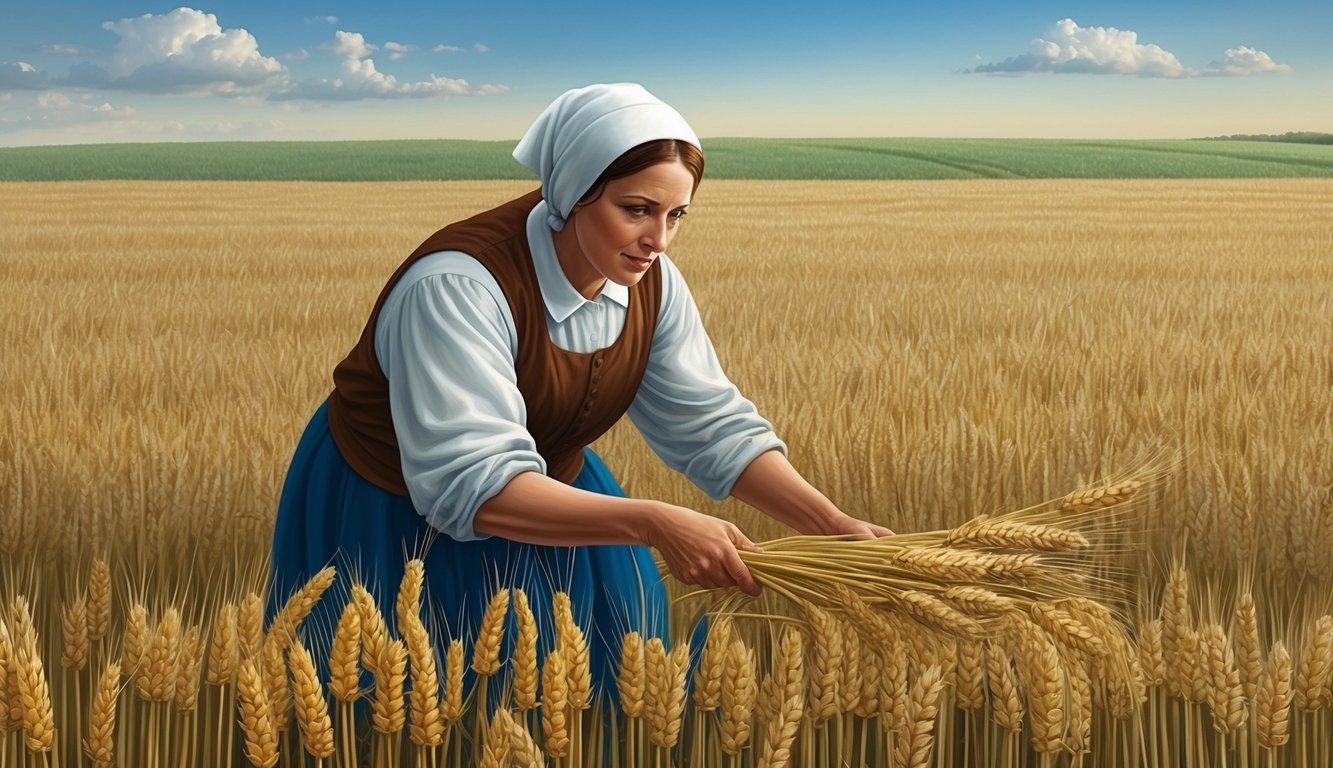Don’t Miss Out On This Unique Astrological Opportunity
Are you tired of spinning your wheels and getting nowhere? Simply put, you’re out of sync: you’re out of alignment with your astral configuration.
But: there’s a kind of map that can help you reclaim your alignment. Think of it as your own personal blueprint to success and happiness: a blueprint that will help you live your most amazing life.
Get started here.
The Book of Ruth tells a story full of warmth and loyalty.
Set in the time of the judges, it follows Ruth and her mother-in-law, Naomi, as they journey from the land of Moab back to Bethlehem.
Despite challenges, Ruth’s steadfast commitment to Naomi becomes a central theme.
Ruth, a Moabite woman, stands out for her loyalty and integrity.
She becomes a vital part of the genealogy of Judaism and Christianity by marrying Boaz, a wealthy landowner.
This union not only secures their future but also ensures Ruth’s place in the family line of King David. Ruth’s devotion and strength make her a significant figure whose legacy endures through generations.
Themes of kindness, redemption, and family bonds resonate throughout the narrative.
The relationship between Ruth, Naomi, and Boaz illustrates faithfulness and love in a powerful way.
This engaging story offers theological insights that have influenced both religious and cultural perspectives.
Key Takeaways
- Ruth’s loyalty and character play a key role in her legacy.
- The story occurs in the context of Bethlehem and Moab.
- Themes of faithfulness and redemption shine throughout the narrative.
Historical and Cultural Context

Ruth’s story unfolds in a time of Judges, a period marked by chaos and hardship.
Understanding the setting and the social-religious norms of the era provides crucial insights into the narrative’s depth and significance.
Setting of the Story
The Book of Ruth is set in the transitional period between the rule of the Judges and the establishment of the monarchy in Israel.
This time is marked by political instability and periodic famine.
The story begins in Bethlehem, which is facing a severe famine that compels Elimelech, Naomi, and their sons to move to Moab.
Moab is a neighboring region often at odds with Israel.
When the family settles in Moab, they integrate into its culture but remain tied to their roots.
After the deaths of her husband and sons, Naomi decides to return to Bethlehem, highlighting the region’s significance and the return of abundance.
The harvest season in Bethlehem becomes a backdrop for Ruth’s journey and transformation.
This period coincides with the Feast of Weeks, or Shavuot, a festival celebrating the grain harvest and God’s provision.
Social and Religious Background
The social and religious backdrop of the Book of Ruth is rich with themes of loyalty, kinship, and faith in the God of Israel.
The narrative highlights the intricate relationships between Jews and Moabites, especially given historical tensions.
During this era, family lineage and land inheritance were pivotal aspects of life.
Ruth’s marriage to Boaz, an Ephrathite from Bethlehem, restores Elimelech’s family line.
Boaz acts as a kinsman-redeemer, a role that reflects Jewish customs regarding family loyalty and property.
This act not only secures Ruth and Naomi’s future but also weaves Ruth into the lineage leading to King David, connecting the narrative to broader themes of faith and divine provision.
Central Characters and Relationships
The Book of Ruth presents strong bonds between its characters.
Ruth, Naomi, and Boaz are central figures, each bringing their unique qualities into the story.
Loyalty, kindness, and family ties are key themes explored through these relationships.
Ruth’s Loyalty to Naomi
Ruth is known for her unwavering loyalty to Naomi.
After the death of her husband, Mahlon, Ruth chooses to stay with her mother-in-law, Naomi, rather than returning to her own family and homeland.
Her famous words, “Where you go, I will go” underscore her deep commitment.
Ruth’s decision reflects a profound sense of duty and love, setting the stage for the unfolding events.
This loyalty is especially significant considering that Naomi’s other daughter-in-law, Orpah, made the opposite choice by returning to her own family.
Ruth’s dedication emphasizes themes of sacrifice and devotion, highlighting her character in the Biblical narrative.
The Character of Boaz
Boaz plays a crucial role as Ruth’s eventual husband and a man of integrity and kindness.
He is introduced as a wealthy and influential figure in Bethlehem with strong morals.
Boaz shows great kindness to Ruth, who is a foreigner and a widow.
He ensures her protection and provides her sustenance when she gleans in his fields.
His actions are infused with chesed, a Hebrew term for loving-kindness, which is central to his relationship with Ruth.
Boaz’s respectful treatment of Ruth and ultimate decision to marry her exemplify the qualities of compassion, responsibility, and honor.
Boaz’s relationship with Ruth not only redeems her but also restores Naomi’s fortunes, underscoring his critical role in their family story.
The Other Family Members
The extended family plays a more passive yet significant role in the story.
Naomi’s husband, Elimelek, and sons, Mahlon and Chilion (sometimes spelled as Kilion), all pass away early in the narrative, setting the stage for Ruth and Naomi’s struggles.
Naomi’s daughters-in-law, Ruth and Orpah, initially start the journey back to Bethlehem with Naomi.
While Orpah returns to her people, Ruth stays.
The family dynamics emphasize loss, perseverance, and the renewal of hope through Ruth’s commitment.
These relationships provide context, showing how personal choices impact the family’s destiny.
The story ultimately revolves around building new family ties, underscoring the importance of loyalty and support amid hardship.
Themes and Symbolism

In the Book of Ruth, several themes and symbols are woven throughout, highlighting the deep relationships and profound beliefs of the characters.
These elements illustrate the ideas of love, loyalty, divine intervention, and social justice.
Love and Devotion
The story reflects a powerful bond between the characters, especially shown through Ruth’s loyalty and devotion to Naomi.
When Ruth, a Moabite widow, chooses to follow Naomi back to Bethlehem, she demonstrates selfless commitment.
Ruth’s decision to stay with Naomi is a testament to their love and reflects the Hebrew concept of Hesed, often translated as loving-kindness or steadfast love.
This devotion is not only towards Naomi but also to the God of Israel, indicating her faith and willingness to embrace a new life.
Divine Providence and Redemption
The theme of divine providence is evident as the events unfold in a way that seems orchestrated by a higher power.
Ruth’s chance meeting with Boaz, a kinsman-redeemer, shows how the characters are guided towards redemption.
This concept is significant in the story as it brings hope and restoration.
Boaz’s role highlights the protective and providential nature of God’s plan, ensuring Ruth and Naomi are cared for.
Their faith in God’s plan enables them to continue despite hardships, illustrating the belief in the justice and mercy of their ancestral faith.
Justice and Social Issues
The narrative sheds light on justice and social issues, particularly concerning vulnerable groups like foreigners and widows.
Ruth, being a Moabite and a widow, faces challenges that highlight societal norms.
The practice of gleaning allows those in need to collect leftover grain from the harvest, emphasizing Boaz’s kindness and adherence to Jewish law.
This act of justice can be seen as a reflection of the community’s moral responsibilities towards the marginalized, offering a deeper understanding of social justice within biblical contexts.
Through actions of kindness and legal adherence, the book portrays a society where justice and mercy go hand in hand.
Theological Significance and Legacy
The story of Ruth in the Bible has a profound theological influence, impacting both genealogy and cultural narratives.
Ruth’s life plays a crucial role in connecting historical figures and shaping religious perspectives.
Genealogy of King David and the Messiah
Ruth’s genealogy is pivotal in the Bible.
She is the great-grandmother of King David, a key figure in the formation of the Israelite monarchy.
Her son, Obed, fathered Jesse, who was the father of David.
This lineage is significant as it connects Ruth to Jesus, through David, highlighting her role in biblical history.
The direct line from David to Jesus also includes figures like Tamar, Rahab, and Bathsheba.
These women are notable for their diverse backgrounds and strong stories.
Ruth’s story shows how unexpected individuals can impact the trajectory of history, emphasizing themes of loyalty and divine providence in the Bible.
Ruth’s Influence in Religion and Culture
Ruth’s story is celebrated in religious texts and teachings.
Her actions and steadfast loyalty to her mother-in-law, Naomi, reflect values such as faith and kindness.
This narrative is central in Jewish and Christian traditions, illustrating how faith transcends cultural and ethnic barriers.
In religious culture, Ruth’s story is often seen as a symbol of redemption and inclusion.
Her acceptance into the community of Israel signifies broader themes of acceptance and unity.
Ruth’s influence extends beyond theology, impacting art, literature, and traditions, showing the ongoing relevance of her story in contemporary discussions about faith and identity.
Frequently Asked Questions

The story of Ruth in the Bible offers insights into loyalty, faith, and devotion.
Ruth’s character and her unique journey provide important teachings and morals that resonate within biblical teachings.
What lessons can we learn from the story of Ruth?
You can learn about unwavering loyalty and dedication from Ruth’s decision to stay with her mother-in-law, Naomi.
The narrative demonstrates the value of kindness and the power of community support in times of hardship.
What is the moral of the story of Ruth as presented in the Bible?
The moral centers around faithfulness and God’s providence.
Ruth’s life shows that staying true to our commitments and treating others with kindness often leads to positive outcomes and divine intervention.
How is the story of Ruth interpreted in biblical teachings?
Biblical teachings interpret Ruth’s story as an example of redemption and divine grace.
It’s seen as a testament to how God cares for those who display loyalty and love, regardless of their background.
What character traits was Ruth known for in the biblical narrative?
Ruth was known for her loyalty, humility, and kindness.
She demonstrated remarkable strength and resilience by leaving her homeland and committing to Naomi, showing great compassion and selflessness in her actions.
In what ways was Ruth’s story unique within the context of the Bible?
Ruth’s story is unique because it highlights the journey of a non-Israelite woman who becomes an ancestor of King David.
Her inclusion tells us about the importance of acceptance and the integration of outsiders within the faith community.
Ruth’s loyalty to Naomi and her willingness to embrace a new faith and people demonstrate the power of devotion and kindness.
Her story contrasts with other complex female figures, such as Lilith in the Bible, who is often associated with independence and defiance.
Through Ruth, we see how acceptance and commitment can lead to a significant place in history, shaping the lineage of Israel’s great kings.
How does the Book of Ruth depict Ruth’s relationship with God?
The Book of Ruth portrays her relationship with God through her actions more than words.
Her devotion to Naomi and her new faith community reflects her acceptance of God.
It showcases her sincere commitment and unwavering trust in divine guidance.



